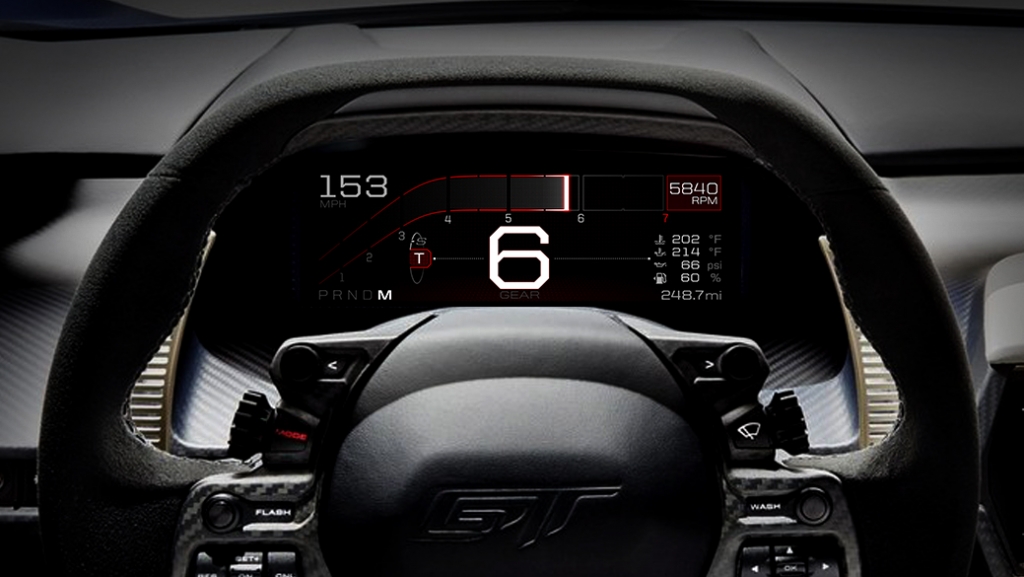
All-New Ford GT Supercar’s Digital Instrument Display is the Dashboard of the Future
Like the glass cockpit in airplanes and race cars, the all-new Ford GT features an all-digital instrument display in the car’s dashboard that quickly and easily presents information to the driver, based on five special driving modes.
The innovative 10-inch wide digital instrument display is far advanced from the original Ford GT, when the cockpit was hardwired with a fixed set of analog gauges, buttons and knobs across the dashboard that had to address almost every situation.
“Driver focus and attention are key with such high performance,” said Jamal Hameedi, chief engineer, Ford Performance. “We’ve designed the GT with a sleek digital instrument display that changes depending on driving mode in ways that are important and usable to the driver.”
Ford engineers and designers created the state-of-the-art 10-inch wide digital gauge cluster to be customisable, elegant, and able to tailor information to each drive mode, to help ensure customers taking the Ford GT to its limits are provided the data they need to make critical decisions behind the wheel in the most efficient possible way.
Defining the visual future of in-car data
The Ford GT programme presented a unique opportunity to reimagine the instrument cluster, further expanding what a connected car can be and previewing the future of Ford vehicles.
Its layout is designed around which data is most important, when to present it, and how to show information in a way that’s most expedient for a driver to process.
The design is executed on a high-resolution display that matches the sleek, purpose-driven cabin. Data is conveyed in crisp, high-contrast graphics.
To test the initial design, Le Mans winner Scott Maxwell of Multimatic® was invited to the Ford GT simulation lab to offer feedback. Maxwell suggested changing the tachometer to provide an expanded view of the EcoBoost® V6 redline approach for greater peripheral visibility. The race car driver also recommended tweaks to the prioritisation of performance information.
Getting every pixel perfect
As advanced design work transitioned to putting prototypes on the road, Ford Performance reached out to suppliers at the cutting edge of data display.
Ford designers and engineers worked closely with Pektron (for electronic design, development, implementation and manufacture) and Conjure (for graphical design) to create forward-looking renderings that are painstakingly animated, include highlighted font, colour and responsiveness, and avoid driver distraction and eye strain.
The five drive modes are easily accessed through steering wheel-mounted controls, to help keep eyes and attention on the road and hands on the wheel.
Each mode presents information differently – prioritising what is crucial for each environment and tailoring the display to the given context.
How information is graphically displayed with each drive mode:
- Normal mode displays information in a purposeful, businesslike manner. The theme is simple; the speedometer is centred and bold, gear selection is to the right, fuel and temperature are top left. The hockey-stick-shaped tachometer displays in a compressed scale for lower rpm, as the engine revs so quickly the lower counts mean almost nothing to the driver. The 3,000-to-7,000-rpm range dominates the top of the display
- Wet mode carries many of the same information concepts over from normal mode, using a blue theme and a “wet floor” concept. Graphics under the speedometer emulate the shine of wet asphalt to remind the driver of the mode selection
- Sport mode adjusts information priorities. Front and centre is gear selection, with the speedometer off to the right and less prominent. It’s displayed in an aggressive orange theme and is the preferred mode for most test drivers
- Track mode presents a stark combination of black background and highly legible text and graphics, in a crisp, red theme that’s easy for the eye to pick up in a fast-paced environment. Gear selection and engine speed are displayed prominently, while coolant temperature, oil pressure, oil temperature and fuel level – rendered as a percentage rather than kilometres to empty – are bottom right
- V-Max offers an entirely different display – purposeful and pared down. Specifically tailored to pursuing maximum top speed, it displays a large, centred speedometer, with tachometer reduced to just a line with indicator dot for minimal distraction. Coolant temperature, oil pressure, oil temperature and turbocharger boost are displayed to the right, with fuel level displayed top left
“We spent an enormous amount of time getting this just right,” says Nick Terzes, Ford GT engineering supervisor. “The result is simple, but achieving simple perfectly can be a challenge.”
Joey Hand, winner of the 24 Hours of Le Mans at the wheel of Ford GT, raved about the different drive modes recently on a visit to Las Vegas Motor Speedway. “This is exactly what I want to see when I want to see it,” he said. “You guys did a great job.”
Dashboard of the Future
GT isn’t the only Ford vehicle that will receive full digital instrument display technology. This innovation is coming to other future Ford vehicles – another example that Ford continues raising the performance bar while ultimately improving vehicles for all of our customers.


























